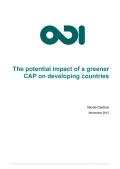
The phrase “Green Economy” was first mentioned in ‘Green Economy Blue Book’ by the British economist Pierre published in 1989. Green Economy promotes economic growth, instead of blocking it in the name of protecting the environment. It advocates changing extensive economic growth with the features of big investment, huge consumption, and serious pollution into intensive economic growth with the features of high efficiency, less resource-consuming, and less waste discharging and calls for harmony between economic and social growth and the proper load that nature can bear. As a new economic model aiming at harmonious development of economy and environment, Green Economy can fully satisfy the requirements of the scientific outlook on development of harmony and people first with energy saving and environmental protection as its goal.
This issue ADB's quarterly magazine explores the concept of green growth: the embracing of environmentally sound and sustainable policies with the need to maintain high economic growth. It features an exclusive interview with leading expert Ashok Khosla, who takes a hard look at the promises and failings of green growth. In other stories, the issue looks at pioneering efforts to deliver medicine through a soda company's distribution network. There is also an article on Cambodia's efforts to pursue green growth.
This guide aims to encourage early dialogue and diagnosis in and by developing countries on what a green economy would mean for their country. Green economy and green growth are hot topics. Definitions, evidence, debates and increasingly, policies, have tended to be dominated by powerful countries and international groups. Several intergovernmental organisations are making it a priority and are announcing policies and programmes; but they each have different approaches. This proliferating work on the international scene provides rich material which can be highly influential in developing countries. However, there are risks of considerable bias if the concepts are not first explored by stakeholders in-country. As the 2012 Rio+20 United Nations Conference on Sustainable Development concluded, green economies should take very different forms according to a country’s diverse capital endowments and needs. As such, green economic policy and investments need to be tailored at both national and local levels.
Green economy policies, if properly designed, deliver social and economic benefits by improving resource efficiency and inducing domestic companies to innovate, which may provide them with a competitive edge – first mover advantage – vis-à-vis their competitors.
Despite the severity of the current financial and economic crisis, it cannot be allowed to distract us from addressing critical and strategic climate change and energy challenges. The energy sector produces 60% of global greenhouse gas emissions and so it must also be a key part of any strategy to reduce them.
This paper describes the most promising low-carbon technologies, their current status and the policy framework that will be necessary to achieve their widespread deployment. It also highlights what immediate steps can be taken as part of a Clean Energy New Deal.
In this report, the WBCSD puts forward six key elements to enhance investments and sales of low-carbon technologies in developing countries. These range from government signals to foster low-carbon solutions to engaging business more actively into the international and national climate change process.
The diffusion of low-carbon technologies to developing countries is necessary to achieving a 450 parts per million (ppm) atmospheric CO2 target and keeping an increase of global temperature below 2ºC.
As key providers of technology and innovation, companies can support these targets but the transition to a low-carbon growth will be facilitated if governments set up frameworks that are conducive to investment in the first place.
Specifically, the six elements to enhancing investments and sales of low-carbon technologies are:
This paper lays out how a ‘green economy’ must be designed to contribute to – rather than distract from – sustainable development. The authors define the equitable green economy as one that is ‘not a state but a process of transformation and a constant dynamic progression. The Green Economy does away with the systemic distortions and dis‐functionalities of the current mainstream economy and results in human well‐being and equitable access to opportunity for all people, while safeguarding environmental and economic integrity in order to remain within the planet’s finite carrying capacity. The economy cannot be Green without being Equitable.’
The paper proposes five key working principles that aim to help inform policy and market decisions in progressing the green economy and providing the link between an equitable green economy and sustainable development. The principles are that the Green Economy:
1. Links to policies specifying clear goals for key cross‐cutting pre‐requisites (enabling conditions) to address systemic distortions and dis‐functionalities in order to establish the foundation for equitable transformation and achieving sustainable development.
With new and emerging technologies, shifts in employment and changes in the workforce are occurring across the world. Employment shifts driven by economic transformation occur at three different levels: (i) across sectors (or industries); (ii) across enterprises within the same or similar sector (industry); and (iii) within enterprises. The speed and the amplitude of job creation and loss across these three levels determine the effects on the number of jobs as well as income.
One of the key challenges facing policymakers in transforming their economies is creating decent and meaningful employment. According to the International Labour Organization (ILO), over 600 million new jobs would be needed in the next 10 years. This paper highlights employment opportunities and key challenges in a transition to a green economy and suggests what policy measures need to be put in place to ensure that newly created jobs can become decent jobs.
